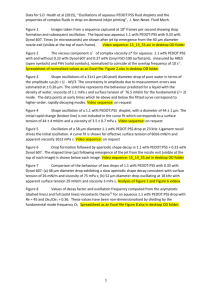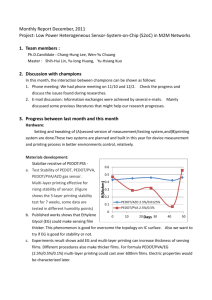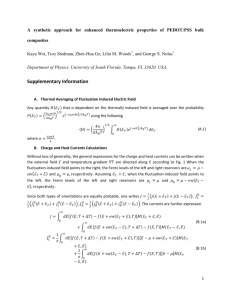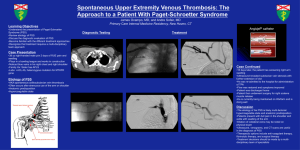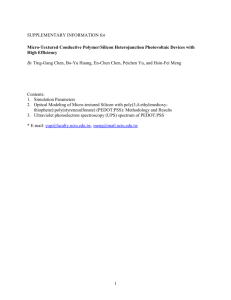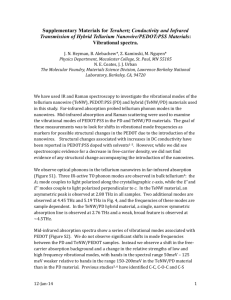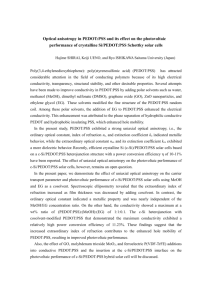DOCX 4MB
advertisement
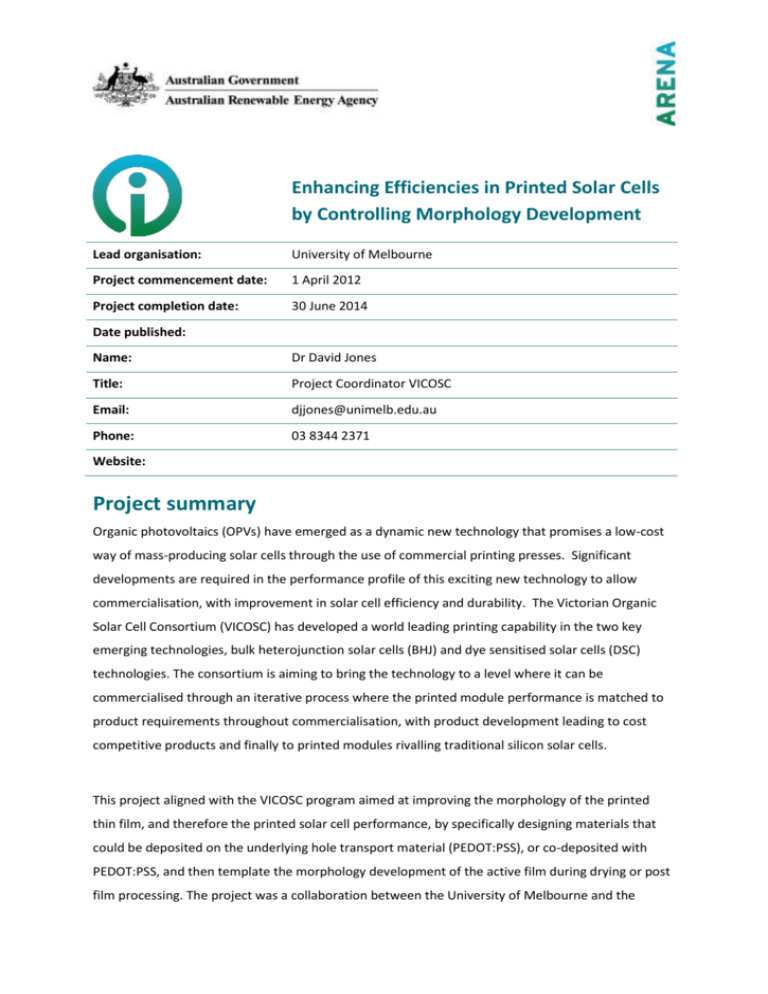
Enhancing Efficiencies in Printed Solar Cells by Controlling Morphology Development Lead organisation: University of Melbourne Project commencement date: 1 April 2012 Project completion date: 30 June 2014 Date published: Name: Dr David Jones Title: Project Coordinator VICOSC Email: djjones@unimelb.edu.au Phone: 03 8344 2371 Website: Project summary Organic photovoltaics (OPVs) have emerged as a dynamic new technology that promises a low-cost way of mass-producing solar cells through the use of commercial printing presses. Significant developments are required in the performance profile of this exciting new technology to allow commercialisation, with improvement in solar cell efficiency and durability. The Victorian Organic Solar Cell Consortium (VICOSC) has developed a world leading printing capability in the two key emerging technologies, bulk heterojunction solar cells (BHJ) and dye sensitised solar cells (DSC) technologies. The consortium is aiming to bring the technology to a level where it can be commercialised through an iterative process where the printed module performance is matched to product requirements throughout commercialisation, with product development leading to cost competitive products and finally to printed modules rivalling traditional silicon solar cells. This project aligned with the VICOSC program aimed at improving the morphology of the printed thin film, and therefore the printed solar cell performance, by specifically designing materials that could be deposited on the underlying hole transport material (PEDOT:PSS), or co-deposited with PEDOT:PSS, and then template the morphology development of the active film during drying or post film processing. The project was a collaboration between the University of Melbourne and the Karlsruhe Institute of Technology (KIT) who provide the project with world leading German expertise and equipment for slot die printing. Collaboration between the Australian and German scientists has been a key feature of this project with an exchange program allowing for the sharing of ideas. Bulk Heterojunction Solar Cells An organic solar cell is a type of flexible solar cell made with polymers, large molecules with repeating structural units, or small organic molecules. Polymer solar cells are organic solar cells (also called "plastic solar cells") and are one type of thin film solar cell. Compared to silicon-based devices, polymer solar cells are lightweight, potentially disposable and inexpensive to fabricate, flexible, and customizable on the molecular level, and they have lower potential for negative environmental impact. An example device is shown in Fig. 1. The disadvantages of polymer solar cells are also important to note, they used to offer only about 1/3 of the efficiency of traditional solar cells, and they are relatively unstable toward photochemical degradation. However, organic solar cells promise of extremely cheap production and, through further development, higher efficiency values has led them to be one of the most popular fields in solar cell research. Therefore, in this project one key Milestone was to improve the performance of lab based BHJ devices (single junction) to over 10% power conversion efficiency to allow translation to VICOSC’s large scale printing program. A no de & A n o d e% I% Acceptor% D onor % C a t hode % Light% Bilayer Device% I& Hole locking layer% or P8cal pacer% Hole&lockiny la yer & or op7cal spacer C a tho de & Electron%lockin la yer% Light Electron blocking&ayer& Bulk& eterojunc7 on device& Figure 1. Bulk heterojunction solar cell device architectures. The simple bilayer device lays the acceptor on the donor but is restricted by the diffusion length of charge carriers in the organic materials. The bulk heterojunction device overcomes the limitations of the bilayer device by forming a mixed phase deposited from a printable ink. The electron blocking layer / Hole Transport layer (PEDOT:PSS) in indicated on the ITO cathode. Project scope Key to success was the design and synthesis of new interface modification agents that could be included in PEDOT:PSS formulations, or that could be deposited on the interface and remaining in place during subsequent printing operations. Report title | Page 2 We examined two key paths to molecular design, i) the inclusion of hydrophilic substituents to aid in solubility of the interface modifier in the aqueous/alcoholic PEDOT:PSS formulation (method A and B in Figure 2), or ii) cleavable side groups that used the acidity of the PEDOT:PSS layer to remove the solubilising group changing the solubility of the interface modifying agent (Method A Figure 2). Polyethylene glycol side chains were chosen to change the solubility as they can be formed in varying lengths and their installation is relatively simple, in addition they are known to improve the performance of the PEDOT:PSS layer by increasing its conductivity. The range of modified templates synthesised is indicated in Figure 3. The ethylene glycol side chains were positioned to examine our ability to control the orientation of the templating interface modifier. Interface modifier (IM) Method A 1. Spin coat PEDOT:PSS 2. Spin coat IM1-3 IM1-3/PEDOT:PSS PEDOT:PSS ITO substrate ITO substrate Method B 1. Blend IM1-3 with PEDOT:PSS 2. Spin coat the Blend ITO substrate IM1-3:PEDOT:PSS Figure 2. Installation of an interface modifying layer (IM) by: A) spin coating on PEDOT:PSS, or B) dissolving in the PEDOT:PSS formulation, co-depositing and migration to the active interface. Polyethylene glycol side chains were chosen to change the solubility as they can be formed in varying lengths and their installation is relatively simple. In addition, they are known to improve the performance of the PEDOT:PSS layer by increasing its conductivity. The range of modified templates synthesised is indicated in Figure 3. The ethylene glycol side chains were positioned to examine our ability to control the orientation of the templating interface modifier. Report title | Page 3 Figure 3. Examples of interface modifiers synthesised and testing during this project. The ethylene glycol substituted materials were designed to be used using both Methods A & B, while the Bocsubstituted material (7) was designed to be applied on the interface and the Boc group removed during annealing, thereby changing the solubility of the reside. Outcomes The program has delivered a key set of design guidelines to allow development of new interface modifiers for new high performance materials as they are developed. The project has demonstrated: i. the use of polyethylene glycol unit allow the interface modifying templates to be deposited on the PEDOT:PSS surface, and remain there during subsequent processing. ii. the use of polyethylene glycol unit allow the interface modifying templates to be codeposited with the PEDOT:PSS layer, and accumulate at the air-PEDOT:PSS interface Report title | Page 4 iii. the use of the Boc protecting group can utilize the inherent chemical nature of the PEDOT:PSS layer to facilitate de-protection changing the solubility of the remaining template. iv. Demonstrated that the impact of template size is important with smaller units, ie templates 6 or 7 without the benzofuran groups, do not act as templates. v. The choice of template group and side-chain position can impact on the orientation of the template group and therefore the morphology development. vi. The design of the interface modifier can act to alter the energy levels of the interface, either to improve device performance or reduce device performance. vii. The morphology can be mapped using 3-D transmission electron microscope (TEM) tomography techniques to visualize changes in the developing morphology (see Figure 4). viii. The developing morphology can be influenced by co-deposited interface modifiers, which can also improve performance of the underlying PEDOT:PSS layer by improving conductivity (see Figure 5). Figure 4. Selected transmission electron microscopy (TEM) tomogram images of an unmodified active layer. The technique was transferred from the TEM laboratories at KIT to the University of Melbourne. Report title | Page 5 Figure 5. Selected 2D grazing incidence-wide angle X-ray scattering (GIWAXS) images of modified substrates showing the impact of the use of interface modification agents. The greater the pattern difference the greater the impact of a) 2/PEDOT:PSS, b) 2:PEDOT:PSS, c) 4:PEDOT:PSS and d) 3:PEDOT:PSS, and vapour + thermally annealed FHBC films on these substrates Initial trials have been completed in translating this technology to larger-scale printed solar cells. However, these trials have been preliminary and require further optimisation to 1) optimize printing conditions for the active layer materials, and then 2) printing trials including the interface modifiers. In addition, the researchers at the University of Melbourne and Karlsruhe Institute of Technology (KIT) have established a high profile through publication of results in leading international journals, and through lectures and articles in both trade magazines and the general literature. The results have resulted in developed IP, which has been covered in a published patent application. Effectiveness The laboratory based program has been very effective in developing quality materials as interface modifiers and demonstrating their effectiveness. The partners have developed a series of design guidelines to allow for faster development of interface materials for any developed higher performance materials in the future. The integration of the printing program has been less than effective, as this relied on organising access to heavily used equipment (and a limited pool of trained operators) often when the equipment was urgently required. This program could be improved by early access to the printers and optimisation of the best active layer materials, then the development of interface modifiers. This would enable rapid optimisation of the use of interface modifiers for an already optimised printing process. Report title | Page 6 Transferability The technology currently developed by the end of the project has the properties required for successful translation to a large scale printing program. The current program has shown that it is possible to develop interface modifiers that can successfully improve the performance of organic solar cells, however the translation to large scale printing has been incomplete. Two key criteria need to be met for translation, 1) the bulk material can be printed successfully, that is translated from the laboratory to large scale synthesis, and 2) an appropriate interface modifier can be developed based on this material. As better high performance materials are developed in the laboratory, and it is shown that they can be translated to a large scale printing program it is expected that new interface modifier will be targeted to aid in the optimisation of the printing program. Conclusion and next steps The project has shown that it is possible to develop interface active agents which can positively influence the developing morphology in organic solar cell active films. Through the work a set of design guidelines have been developed to allow new interface modifiers to be developed as new higher performing materials are discovered. For example, a new molecular material has been developed at the University of Melbourne which shows record performance in organic solar cells and the material has the added benefit of performing very well with thick films aiding the printing process. The design criteria for interface modifiers will be used to develop new interface modifiers for this very high performance material. The translation of the work to large scale printed modules needs to be extended. A key conclusion is that only materials which can be translated successfully to a printing program should be used as target materials for interface modification. Report title | Page 7
